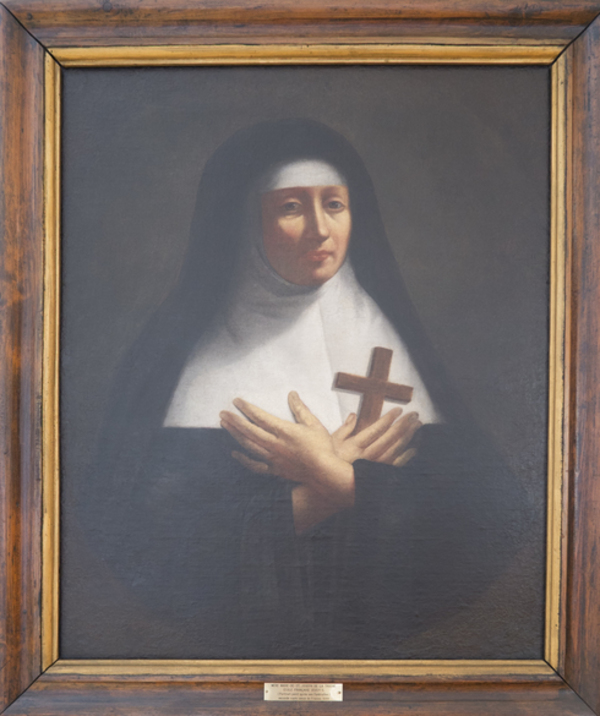
Source: Link
SAVONNIÈRES DE LA TROCHE, MARIE DE, dite Marie de Saint-Joseph, Ursuline nun, first known as Marie de Saint-Bernard; b. 7 Sept. 1616 at the Château de Saint-Germain in Anjou; d. 4 April 1652 at Quebec.
Her father, Simon de Savonnières de La Troche, of Saint-Germain, Les Hayes, and elsewhere, and her mother, Jeanne Raoul, were both noted for their nobility and integrity. From her childhood, Marie de Savonnières was much attracted to the pious life. She joined the Ursulines of Tours at the age of 14 and made her profession under the name of Marie de Saint-Bernard. Towards 1636, she heard about Canada, and her interest in distant missions was aroused. Three years later, she volunteered to accompany Marie de l’Incarnation [see Guyart] to Canada. Her heart-broken parents did not conceal their opposition to her departure. The young Ursuline then appealed to St. Joseph to change her family’s attitude. To show her gratitude and to discharge a vow she had made, Mother Marie de Saint-Bernard assumed the name Marie de Saint-Joseph. She sailed for New France in 1639. On her arrival in the colony, she devoted herself to the study of the Huron and Algonkin languages. Contemporaries who knew her describe her as being extremely good-humoured, keen of mind, and well informed. As a result, she soon won the confidence of the Indians, who addressed her as their mother.
The last four years of her life were a continuous martyrdom which she endured in heroic fashion. After the destruction of the convent by fire (1650), her parents urged her to return to Tours, but she refused, wanting to offer her suffering for the conversion of the Indians. The community had received shelter in the house of Madame Chauvigny de La Peltrie, and there the sick nun was made very uncomfortable by the crowded quarters, the noise, the smoke, and the smell of eels. She was soon suffering not only from tuberculosis but also from dropsy and gangrene. Mother Marie de Saint-Joseph died 4 April 1652, regretted by all, and especially by the Hurons who were inconsolable at the loss of so saintly and lovable a person. She was buried the following day in the convent garden. According to contemporary reports, it was the most impressive funeral procession ever witnessed in the colony. The history of the convent records several miraculous occurrences attributed to Mother Marie de Saint-Joseph’s collaboration. To honour her companion and favourite nun, Marie de l’Incarnation composed an obituary in the form of a booklet that is of great interest despite its somewhat conventual tone. This document, most of which was incorporated into the Relation for 1652, provides ample proof that Mother Marie de Saint-Joseph was an exceptional woman and one of the glories of the Church in Canada.
Marie Guyart de l’Incarnation, Écrits (Jamet). JR (Thwaites), XXXVIII, 79–91, 143. Les Ursulines de Québec, I.
Marie-Emmanuel Chabot, o.s.u., “SAVONNIÈRES DE LA TROCHE, MARIE DE, dite Marie de Saint-Joseph (Marie de Saint-Bernard),” in Dictionary of Canadian Biography, vol. 1, University of Toronto/Université Laval, 2003–, accessed November 28, 2024, http://www.biographi.ca/en/bio/savonnieres_de_la_troche_marie_de_1E.html.
The citation above shows the format for footnotes and endnotes according to the Chicago manual of style (16th edition). Information to be used in other citation formats:
| Permalink: | http://www.biographi.ca/en/bio/savonnieres_de_la_troche_marie_de_1E.html |
| Author of Article: | Marie-Emmanuel Chabot, o.s.u. |
| Title of Article: | SAVONNIÈRES DE LA TROCHE, MARIE DE, dite Marie de Saint-Joseph (Marie de Saint-Bernard) |
| Publication Name: | Dictionary of Canadian Biography, vol. 1 |
| Publisher: | University of Toronto/Université Laval |
| Year of publication: | 1966 |
| Year of revision: | 1979 |
| Access Date: | November 28, 2024 |